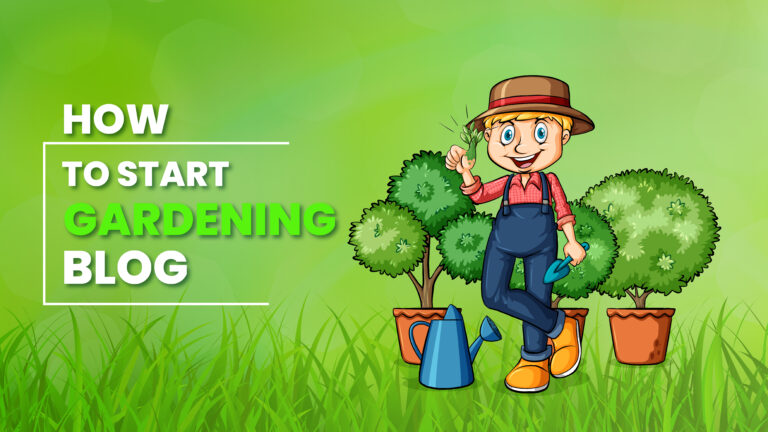Gardening is no longer just a hobby; it has become a passion, a lifestyle, and a creative outlet for millions of people worldwide. Starting a gardening blog in 2026 allows you to share your knowledge, inspire others, and build a community around a love for plants and green spaces. Whether you are passionate about organic gardening, indoor plants, landscaping, or DIY garden projects, a well-crafted blog can help you connect with readers, showcase your expertise, and even generate income through smart strategies like affiliate marketing and sponsored content. With the right approach, your gardening blog can grow into a trusted resource for enthusiasts and beginners alike.
What is a Gardening Blog?
A gardening blog is more than just a website; it’s a vibrant space where plant enthusiasts, hobbyists, and experts come together to share their passion for gardening. From practical tips to creative DIY projects, a gardening blog helps readers discover ways to cultivate healthy plants, design beautiful outdoor spaces, and improve their green thumb. It’s a platform where knowledge meets inspiration, allowing both beginners and seasoned gardeners to learn and grow.
These blogs can include diverse content, such as guides on plant care, seasonal gardening advice, landscaping tips, and product reviews. They serve as a resource for anyone looking to enhance their garden, explore sustainable practices, or simply enjoy the beauty of nature right at home.
Why Start a Gardening Blog in 2026?
Gardening is experiencing a surge in popularity, making 2026 an ideal year to start your blog. With increasing interest in eco-friendly living, creative outdoor projects, and indoor plant care, a gardening blog can attract a dedicated and engaged audience.
Key reasons to start now include:
- Sustainable living: More people are seeking eco-friendly gardening practices.
- Indoor and urban gardening: Perfect for city dwellers with limited space.
- DIY landscaping projects: Homeowners want practical tips for beautiful gardens.
- Environmental awareness: Gardening encourages greener lifestyles and environmental responsibility.
- Stress-relieving hobby: Gardening is recognized for its mental health and relaxation benefits.
Starting a gardening blog in 2026 allows you to educate readers, share your expertise, and create opportunities for monetization through affiliate marketing, sponsored content, and digital products.
How to Start a Gardening Blog in 2026
Gardening blogs continue to grow in popularity as more people embrace home gardening, sustainable living, and DIY landscaping. Starting a gardening blog in 2026 allows you to share your expertise, inspire readers, and build a loyal audience. With the right strategy, you can also monetize your blog while helping others cultivate beautiful gardens.
1. Define Your Gardening Niche
A clear niche helps your blog stand out and attract the right audience. Consider your expertise and passion when choosing a niche. Popular niches in 2026 include:
- Organic gardening and sustainable practices
- Indoor plants and houseplant care
- Vegetable and herb gardening
- Landscaping, garden design, and DIY projects
- Seasonal gardening tips
Focusing on a niche ensures your content remains relevant and targeted.
2. Choose the Right Blogging Platform
Select a blogging platform that offers flexibility, customization, and SEO capabilities. Recommended platforms:
- WordPress.org: Most popular for scalability, themes, and plugins
- Wix: Beginner-friendly drag-and-drop interface
- Squarespace: Ideal for visually stunning blogs
For long-term growth, self-hosted WordPress is the best option.
3. Pick a Domain Name and Hosting
Your domain name should reflect your niche, be memorable, and easy to spell. Reliable hosting ensures your site is fast, secure, and always accessible.
Tips for 2026:
- Keep it short and brandable
- Include keywords like “garden,” “plants,” or “gardening tips” if possible
- Choose hosting providers with excellent speed and uptime (e.g., Bluehost, SiteGround, HostGator)
4. Design Your Blog
A clean, visually appealing design keeps readers engaged. Use a gardening-themed layout with intuitive navigation and mobile responsiveness.
- Pick a theme that aligns with your niche
- Customize colors, fonts, and layout for readability
- Ensure fast loading and a mobile-friendly design
5. Create Essential Pages
Your blog should include pages that establish trust and clarity:
- About Page: Share your story and purpose
- Contact Page: Let readers and brands reach you
- Privacy Policy: Required for legal compliance and trust
6. Develop a Content Strategy
High-quality content is the foundation of your blog. Plan topics around your niche, audience interests, and trending gardening queries.
Content ideas:
- How-to guides (planting, pruning, composting)
- Seasonal tips (spring planting, winter care)
- Product reviews (tools, seeds, fertilizers)
- DIY projects and creative garden ideas
- Videos, infographics, and photo tutorials
Consistency is key aim for one to two posts per week.
7. Optimize for SEO
SEO ensures your blog reaches readers organically. Focus on both on-page and off-page SEO techniques:
- Research keywords using tools like Google Keyword Planner or Ubersuggest
- Use keywords naturally in titles, headings, and meta descriptions
- Add alt text to images for better visibility
- Include internal links between related posts
- Ensure fast loading and mobile optimization
8. Promote Your Blog
Promotion drives traffic and builds your audience. Use multiple channels for maximum reach:
- Social Media: Instagram, Pinterest, and Facebook are ideal for visual gardening content
- Email Marketing: Build a newsletter to share updates and tips
- Collaborations: Guest posts or partnerships with other gardening bloggers
- Communities: Join online gardening groups and forums
9. Engage with Your Audience
Reader engagement fosters loyalty and encourages repeat visits:
- Respond to comments on your blog and social media
- Conduct polls or surveys to understand reader preferences
- Host live Q&A sessions or garden challenges
- Encourage user-generated content, like photos of readers’ gardens
10. Monetize Your Gardening Blog
Once you have an audience, explore monetization opportunities:
- Affiliate marketing (tools, seeds, or gardening courses)
- Sponsored posts and brand collaborations
- Selling eBooks, printables, or online workshops
- Paid memberships or premium content
11. Track Performance and Improve
Use analytics to understand your blog’s performance and refine your strategy:
- Monitor traffic sources, bounce rate, and popular content
- Test different content formats and publishing times
- Adjust SEO and promotion strategies based on data
12. Stay Updated and Network
Stay current with gardening trends and connect with others:
- Follow gardening blogs, magazines, podcasts, and forums
- Attend online webinars or gardening events
- Collaborate with other bloggers to expand your reach
Conclusion
In 2026; Starting a gardening blog is the perfect way to share your passion for plants, home gardening, and eco-friendly landscaping while building a loyal online community. By choosing a clear gardening niche such as organic gardening, indoor plants, vegetable gardens, or DIY landscapingyou can create high-quality, informative content that resonates with readers. Consistently publishing gardening tips, seasonal guides, and plant care tutorials not only boosts your blog’s search engine visibility but also positions you as a trusted gardening resource.
Promoting your blog through social media platforms like Instagram, Pinterest, and Facebook, engaging with your audience, and leveraging SEO strategies ensures steady growth and increased traffic. Additionally, monetizing your gardening blog through affiliate marketing, sponsored posts, or selling digital gardening products can turn your passion into a sustainable income stream. With dedication, creativity, and strategic planning, your gardening blog can flourish in 2026 and become a go-to destination for gardening enthusiasts worldwide.
Frequently Asked Questions (FAQs)
What topics should I cover in a gardening blog in 2026?
Focus on popular and practical topics like organic gardening, indoor plants, vegetable and herb gardening, seasonal planting guides, pest control, garden design tips, and DIY landscaping projects. Covering these areas helps attract readers who are actively searching for actionable advice.
How do I choose the best plants to feature on my blog?
Highlight plants that are easy to grow, visually appealing, or trending among gardening enthusiasts. Include detailed care guides, seasonal tips, and troubleshooting advice. This ensures your content is valuable and encourages readers to return.
What essential gardening tools should I recommend?
Include commonly used tools such as pruning shears, trowels, watering systems, compost bins, and gloves. Adding product reviews, usage tips, and comparison guides can increase engagement and trust with your audience.
How often should I publish new gardening content?
Consistency is key. Publishing 1–2 high-quality posts per week keeps your audience engaged and improves your blog’s visibility on search engines. Seasonal updates or trending gardening topics can further boost traffic.
Do I need to use SEO for my gardening blog?
Absolutely. Optimizing content with relevant keywords, descriptive headings, internal links, image alt text, and meta descriptions ensures your blog ranks higher and reaches readers actively looking for gardening solutions.
What strategies help grow a gardening blog audience?
Use a mix of social media promotion, collaborations with other gardening bloggers, participation in online communities, email newsletters, and engaging visuals like videos or infographics. Providing consistent, valuable content encourages loyalty and sharing.

